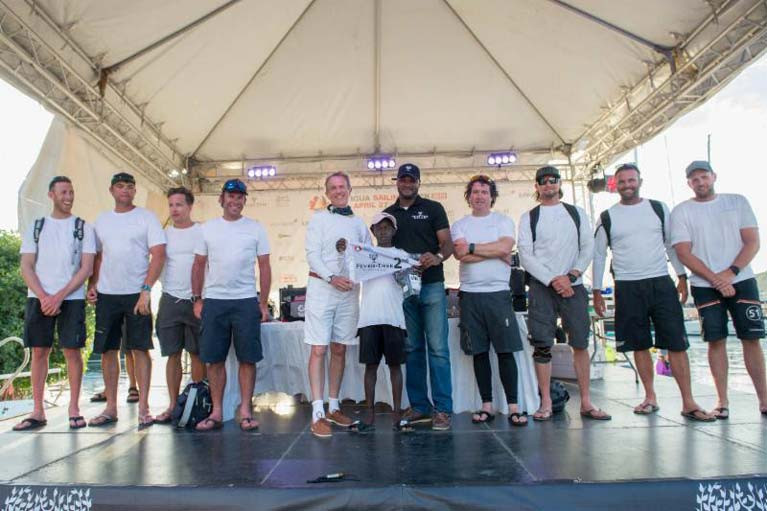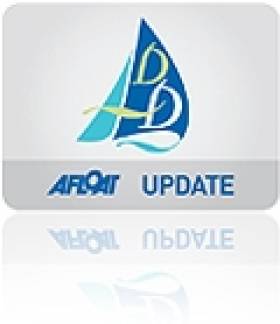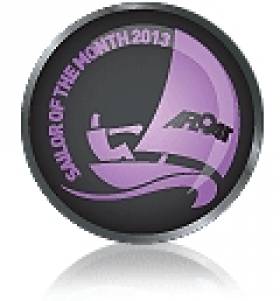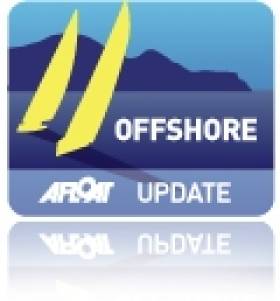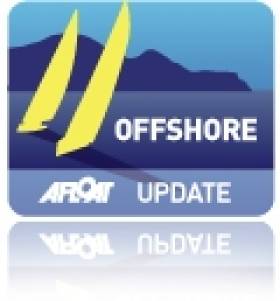Displaying items by tag: Adrian Lee
The Royal St. George Yacht Club's 2009 winning skipper Adrian Lee will be racing his Swan 60 Lee Overlay Partners II in next month's RORC Caribbean 600 writes Louay Habib.
For the 12th edition of the RORC Caribbean 600, 21 teams - racing yachts of 50ft (15.24m) or over - have already signed up for the 600-mile blast around 11 Caribbean Islands. The competition in all the classes will be as fierce as ever. However, history has shown that the best performer in the big boat class is likely to be rewarded with the overall win. Since the first race in 2009 overall victory under IRC for the RORC Caribbean 600 Trophy has been dominated by big boats.
The racecourse and weather combine to produce a thrilling race in tropical heat with non-stop action for the international fleet. In February, the trade winds are pumping over 20 knots with up to two metres of swell. The course design capitalises on these stunning conditions with numerous legs off the breeze. This combination provides spectacular racing at full pelt.
Peter and David Askew (USA) racing Volvo 70 Wizard will be defending last year's overall win. Wizard's crew will include stars from the Volvo Ocean Race: Charlie Enright (USA), Robert Greenhalgh (GBR), Phil Harmer (AUS), Will Oxley (AUS), Mark Towill (USA), Curtis Blewett (CAN) and Richard Clarke (CAN).
"It's the toughest 600-mile race in the world. Lots of turns and always windy," commented Peter Askew. "We are most looking forward to being out of the cold Mid-Atlantic USA weather for a week in late February. The course in general is what makes the event unique; sailing for 600 miles through all the islands is a blast and the beautiful trade wind sailing conditions are perfect for our boat."
Ron O'Hanley (USA) racing Cookson 50 Privateer was the overall winner in 2013 and came second overall to Rambler 88 in 2018. Boat Captain Scott Innes-Jones (NZL) is looking forward to racing in 2020.
"Privateer is a good all-rounder, so we need a bit of everything," commented Innes-Jones. "If we just get big reaching, the bigger boats put us away, but if there are a couple of slow spots we can come back at them. Since the boat was originally designed it has really changed; we have optimised Privateer as best we can. To win you have to sail well and have a bit of luck, everything has got to go your way."
Four examples of Nautor's Swan have already entered the 2020 RORC Caribbean 600, including 2009 winning skipper Adrian Lee (IRL) who will be racing his Swan 60 Lee Overlay Partners II. Swan 95 Lot 99, sailed by Jeroen Van Dooren (NED) is the largest Maxi entered to date. Race founder and long-standing RORC member John Burnie (GBR) will be taking part in his tenth race on board Lot 99. Burnie has raced on board a number of Maxis and superyachts in the race. In 2009, Burnie skippered Claude Telier's Orma 60 Région Guadeloupe to victory in the Multihull Class, setting a record that was not bettered until 2015.
"In Caribbean conditions waterline length is quite critical and it's a very thrilling ride," commented Burnie. "So much of the course is fast reaching, especially Tintamarre to Guadeloupe and La Désirade to the Barbuda mark. However, these legs are unlike other long races, as even on a Maxi, the corners come up fast and you can't really relax - you are always preparing for the next manoeuvre. This makes for fantastic sailing, particularly at night when it is absolutely sensational. Teamwork is everything, inevitably when you race on a boat of that size you have a range of sailors that have come together, and when you finish the race, you get a wonderful greeting from the volunteers dockside with cold beer - it is a euphoric moment for the whole team!"
Lee Overlay Partners II will be racing in IRC One and similar rivals include the classic 1974 restored Swan 65 Libélula, sailed by Francisco de Borja Pella (ESP) and OnDeck's Paul Jackson racing Antiguan Farr 65 Spirit of Juno. Proven winners in IRC One include: Giles Redpath (GBR) racing Lombard 46 Pata Negra, Philippe Frantz's (FRA) NM43 Albator and RP37 Taz, raced by Bernie Evan Wong (ANT) who has competed in every edition of the race.
New to this year's race will be GP42 Phan which has been chartered by Patrick and Catherine Keohane (GBR). The couple have raced before, but this is the first time in IRC One. The pocket rocket will be co-skippered by Catherine Keohane and performance coach Nigel King.
"The course is in itself a challenge and this, combined with the weather, offers a great test for all," commented Keohane. "There are parts of the course where you really need to be on top of your game anticipating weather, affects from the islands, and try to think three steps ahead tactically to gain an advantage. We have put together an international team and the challenge will be in getting the team to gel, be competitive and have fun on the water!"
The 12th edition of the Royal Ocean Racing Club's RORC Caribbean 600 will start on Monday 24th February 2020 from Antigua.
Irish Sailors Up For It In RORC Caribbean 600
For those reared in the simple certainties of the course in the offshore classics like the Rolex Fastnet Race and the even more clearly defined Volvo Round Ireland Race, the multi-island RORC Caribbean 600 which starts tomorrow (Monday) morning at Antigua is a strange beast writes W M Nixon.
Set against the straight-line austerity of other long-established classics such as the Newport-Bermuda and the Rolex Sydney-Hobart, its weaving course makes it seem almost fussy. But in a typical February in the Northern Hemisphere, people will happily race round as many islands as are required to make the magic 600 miles total. Just so long as it’s in those marvellous Caribbean sailing and climatic conditions which contrast so totally with what many other areas of the Northern Hemisphere are experiencing in this dank dark cold month.

It’s a busy course – with so many islands to be ticked off, navigators could usefully employ the services of a continuity director…
Eleven islands are required to act as race marks in order to put sufficient mileage in the course. But with 77 boats – many of them noted superstars – tuned up and ready to go, it’s clear that the huge variety of legs both long and short which have to be sailed is no deterrent, and Irish interest is high both in terms of participation, and in the presence of international contenders expected for the Volvo Round Ireland Race in June.
Then too we’ve a certain proprietorial interest. The Caribbean 600 having been inaugurated as recently as 2009, it’s a modern classic. And the fact that on its first staging, it was won overall by Adrian Lee’s Cookson 50 Lee Overlay Partners from Dun Laoghaire, makes it extra special. For in her previous life as Ger O’Rourke’s Chieftain, the Lee ship had been overall winner in the Rolex Fastnet Race 2007, providing the rare if not unique situation that the same Irish boat won two classics in the space of just 18 months.
Six years later, the ever-green Cookson 50 is such a good all-rounder that she’s still very much in the hunt, and Lee Overlay Partners is in the listings for tomorrow’s start, the smallest boat in the six strong canting-keel division which includes such giants as Jim and Kristy Hinze Clark’s mega-powerful hundred footer Comanche.
We’ve interest throughout the race, as in addition to Lee Overlay Partners, the fleet includes two Howth Yacht Club crews. Howth sailors with the likes of Kieran Jameson on the strength have already got involved in past seasons in the Rolex Middle Sea Race with a Performance Yacht Charter’s First 40, and now with two of PWC’s boats of this proven marque on the other side of the Atlantic, there with PYC’s Lucy Johnson on Southern Child are Howth men raring to go Caribbean island-rounding. Much of the Howth team assembled by Darren Wright for the 2014 Rolex Middle Sea Race are re-joining the same boat, Southern Child, and their lineup incudes Kieran Jameson, Frank Dillon, Rick de Neve, Jonny White, Colm Bermingham, while new talent in the form of Michael Wright, recently-retired HYC Commodore Brian Turvey, and young Howth K25 squad member Luke Malcolm are also on the strength.
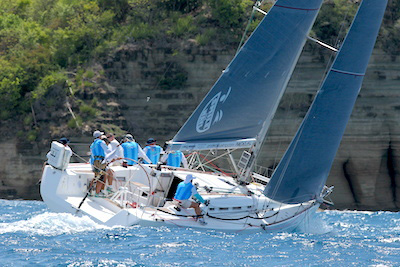
One of the two Howth crews will be racing the First 40 Southern Child, which they’ve already campaigned in the Rolex Middle Sea Race
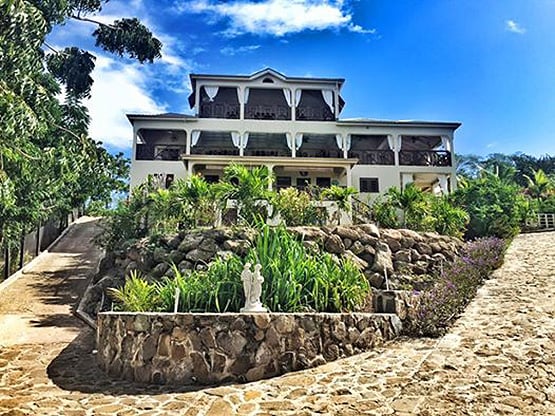
Howth Yacht Club Headquarters for the RORC 600: Villa Touloulou
Up against them to provide a spot of in-club competition is HYC’s Conor Fogerty who is doing an Atlantic circuit as a mix of racing and cruising with his new Sunfast 3600 Bam, a boat which might have been designed with RORC Caribbean 600 enjoyment in mind. Bam’s racing crew coming out from home include Simon Knowles, Daragh Heagney, Paddy Gregory, Roger Smith and Anthony Doyle. After Bam sister-ship Red Shift’s success in last year’s race, Conor Fogerty has great hopes for his stylish boats showing once tomorrow has seen the start – usually a very challenging business in itself – get cleanly away.
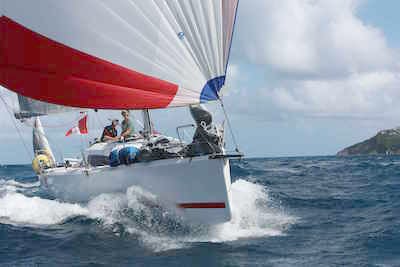
Conor Fogerty’s Sunfast 36 Bam from Howth is doing the RORC Caribbean 600 as part of an Atlantic odyysey
Ireland’s own RORC Commodore Michael Boyd of the RIYC, who won the Gull Salver for best-placed Irish boat in last year’s Fastnet Race with the Grand Soleil 43 Quokka 8, is helping to pass the time while waiting for delivery of his new JPK 10.80 by racing the Caribbean as navigator on Andy McIrvine’s Grand Soleil 46 Bella Donna.
As for pointers towards the Volvo Round Ireland Race in June, the two MOD 70 trimarans already signed up for it, Lloyd Thornburg’s Phaedo 3 and Concise 10 (Tony Lawson & Ned Collier Waefield) are both g0ing for the Caribbean 600.

Lloyd Thornburg’s MOD 70 Phaedo 3 is one of two sister-ships entered for the Volvo Round Ireland Race 2016 which are also doing the Caribbean 600, the other being Concise 10.
In fact it’s a very eclectic fleet, as Eric de Turckheim’s noted Commodore’s Cup contender of 2014, Teasing Machine from France, has somehow got herself to the Caribbean after being far away to cut a successful swathe through the recent Rolex Sydney-Hobart Race. And up towards the top of the fleet, the 72ft mini-maxi Momo, which was best of the bigger boats in last summer’s Fastnet, find herself up against Hap Fauth’s similarly-sized superstar Bella Mente, which had to scratch from the 2015 Fastnet Race for personal reasons after a blisteringly successful Cowes Week, but is now set to go in a race in which she is the defending champion.

Back to the fray. Having been forced to scratch from the Rolex Fastnet 2015 in which she was a favourite, Hap Fauth’s 72ft mini-maxi Bella Mente is very much in the hunt in tomorrow morning’s RORC Caribbean 600, in which she is defending champion.
The 72ft mini-maxis seem to be the favoured size of boat o the most recent peformances, as Nik Zennstrom’s Ran won in 2012, George Sakellaris’s Shockwave won in 2014, and Bella Mente won in 2015. But the evergreen Cookson 50 is a good steady bet, with Lee Overlay Partners; win in 2009, and Ron O’Hanley’s with Privateer in 2013.
The RORC Caribbean 600 starting process gets under way at 1030hrs local time tomorrow morning off Antigua, and there are going to be 77 very busy crews having more than a few dry-mouth moments before they get clear away around this island’s beautiful east coast.
#d2d – The canting-keel Cookson 50 Lee Overlay Partners skippered by Dun Laoghaire's Adrian Lee is the latest high profile entry into this June's Dun Laoghaire to Dingle race. The Royal St. George yacht is a proven offshore winner, taking the inaugural 2009 RORC Caribbean 600 race and overall victory (as Chieftain) in the 2007 Fastnet Race.
Most recently, in 2013, the globe trotting 50–footer set a course record of 2 days 53 minutes and 40 seconds and the overall win in the 360– mile race from Dubai to Muscat in Oman. In what is looking like a potent line-up for the 12th edition of the National Yacht Club race, this Dun Laoghaire entry joins the Commodore's Cup winning Ker 40, Catapult skippered by Anthony O'Leary of Cork, Afloat's 2014 Sailor of the Year.
Adrian Lee is Afloat's Sailor of the Month for November
#rorc – For many decades, the Straits of Hormuz were one of those potential flashpoints which could have ignited World War III. In an oil-rich region of extreme political and religious turbulence, this narrow channel connecting the The Gulf with the oceans of the world has been just about the last place you would have thought of routing an offshore race.
Yet there are few things more strongly symbolic of peace than a pleasure boat sailing about her business, even if the business is the cut-throat matter of winning an offshore race. In fact, pleasure boating in all its forms is the essence of peaceful pursuits, something well-recognised by those who promoted the building of the Shannon-Erne Waterways right through the middle of a border area which was suffering grievously throughout Ireland's "Troubles" from 1969 to 1998.
And in offshore racing, these days we think it perfectly normal that Harry Donegan of Cork with his cutter Gull should have been one of the seven entrants in the inaugural Fastnet Race in 1925. Yet that first Fastnet Race was not only staged just three years after the Irish Free State had been established, but its course took the contenders right into the territorial waters of the Rebel County's most rebellious region of West Cork. The presence of the Gull in the race was a powerful gesture of peace and reconciliation.
The 360 mile race from Dubai to Muscat in Oman may take place between two states which are receptive to western concepts, but with Iran looming close to the north and Saudi Arabia a huge presence to the south, it's a bizarre enough setting for something so western as modern offshore racing. Yet is has been staged annually for 22 years now, but it is only relatively recently, as the first green shoots of a greater peacefulness spread over the Gulf area, that it has been allowed to achieve the kind of publicity it deserves.
So from being a fleet of local Dubai-based boats which just nipped round the corner to Muscat, it has begun to attract high profile entries to race a course which re-traces part of the ancient spice voyaging routes. But though the local Dubai-based inshore racing sports dhows can reach remarkable speeds, for the demands of a 360 miles offshore in the first weekend of November 2013 it was a tried and tested classic modern offshore racer, the canting-keel Cookson 50 Lee Overlay Partners, which did the business to take a new course record of 2 days 53 minutes and 40 seconds and the overall win, adding them to her overall victory (as Chieftain) in the 2007 Fastnet Race, and her overall win in the inaugural 2009 RORC Caribbean 600 race.
Skipper Adrian Lee hit a happy moment, as his club, the Royal St George YC in Dun Laoghaire, was at precisely the same time celebrating its 175th anniversary by honouring the 597 members who had won major sailing prizes down the years. The Lee victory brought the total up to 598 before the weekend was over. Lee Overlay Partner's crew for the Dubai-Muscat Race 2013 were James Hemingway, Ilya Lee Paveliev, Scott Wilson, Emmet Kerin, James Gunn, Tim Corney, Neil Harrison, Ruairi Herraghty, Robert Witte and Daniel McKeown, and their skipper Adrian Lee is very deservedly the Afloat.ie "sailor of the Month" for November.
Dublin Yacht Claims Middle East Sailing Record in Dubai to Muscat Race
#offshore – As Afloat.ie reported earlier this morning, Adrian Lee's Cookson 50, Lee Overlay Partners, has claimed line honours for the IRC Racing Division in the 2013 Dubai to Muscat Race writes Louay Habib
The Irish canting keel racing yacht crossed the finish line at Muscat on Tuesday, 5 November at 11:58 40 seconds (local time). Lee Overlay Partners elapsed time for the race was 2 Days 53 Mins at 40 Secs, setting a new course record for the 360-mile race.
Adrian Lee was full of praise for his crew, after breaking the monohull record for the longest offshore yacht race in the Arab region that has lasted for 13 years.
"The crew have been absolutely first class, we have sailed together for many years and beating the course record is a very special moment for us. We think we have done well on handicap but we will just have to see how the competition does before we will really know. I think we made some excellent tactical decisions and if we had to run the same race again, I doubt if we would have changed much. What has really surprised me about the race is the 30 knots of wind we experienced for most of yesterday. It was not forecast and seemed to just come from nowhere. The boat was sitting at 16 knots for long periods and flying down the beautiful Omani coast line was very special. We have received a very warm welcome at Bandar Al Rowdha Marina"
Lee Overlay Partners for the Dubai to Muscat Race: Adrian Lee, James Hemingway, Ilya Lee Paveliev, Scott Wilson, Emmet Kerin, James Gunne, Tim Corney, Neil Harrison, Ruairi Herraghty, Robert Witte and Daniel McKeown, who took the photo as the team crossed the finish line.
The 22nd Dubai to Muscat Race is organised under the auspices of the Royal Ocean Racing club. HH Sheikh Khaled Bin Zayed Al Nehayan was the guest of honour for the start. The 360-mile race is the longest offshore yacht race in the region and is organised by The United Arab Emirates Sailing and Rowing Federation in association with the Ministry of Sports Affairs, the Sultanate of Oman.
Dublin Sailor Leads the Fleet From Dubai to Muscat
#offshore – Dublin''s Adrian Lee leads the fleet out of Dubai in a non stop offshore race to Muscat today. The Dun Laoghaire Cookson 50, Lee Overlay Partners from the Royal St. George Yacht Club was given a royal send off when HH Sheikh Khaled Bin Zayed Al Nehayan, President of the UAE Sailing and Rowing Federation, was the guest of honour for the start of the 22nd edition of the Dubai to Muscat Yacht Race.
All the yachts are now sailing 360-miles non-stop to Muscat.
Lee is no stranger to international offshore success taking RORC's Caribbean 600 in 2009.
Scroll down this page to listen to an interview with Adrian from the race course via satellite phone with Louay Habib.
Two Irish Boats for Transatlantic Race 2011
Two big names in Irish offshore racing are among the 30-boat fleet preparing for the Transatlantic Race 2011 (TR 2011) this June. Last night the organisers, the Royal Yacht Squadron, New York Yacht Club, Royal Ocean Racing Club and Storm Trysail Club, extended the deadline to enter the Race to March 31, 2011.
Adrian Lee's Cookson 50 from Dublin Bay and the Limerick Volvo 70 skippered by Ger O' Rourke's both make the entry list although the Shannon estuary's Chieftain is described only as a 'provisional' entry. For Entry list click HERE.
With the Transatlantic fleet now over 30 entries and many new inquiries following the success of the RORC Caribbean 600 - part of the companion Atlantic Ocean Racing Series - the organisers encourage those interested to enter the TR 2011 as soon as possible to secure a spot since the Notice of Race notes a maximum of 50 yachts for the race.
The TR 2011 will cover 2,975 miles from Newport, R.I., to the Lizard in England. The focus of pre-race activities will be the New York Yacht Club's Harbour Court clubhouse in Newport, R.I. There will be three staggered starts from June 26 to July 3. The awards ceremony on August 9th and other post-race activities will be held at the Castle, the home of the Royal Yacht Squadron in Cowes, England.
The fleet will include IRC Racing, IRC Racer/Cruiser, Classic and Open divisions with a minimum length overall (LOA) of 40 feet and no maximum. Competition is building within several segments of the diverse fleet, notably the 100' and up range which includes Sojana, Rambler 100, ICAP Leopard, and Maltese Falcon.
Tight racing is also expected in other classes and divisions, such as yachts in the under 50' range in IRC Racing and IRC Racer/Cruiser including the Class 40s - Concise 2, Dragon, and Kamoa'e, the Rogers 46s - Shakti and Varuna, as well as British Soldier ASA, Jacqueline IV, Sasha, Dawn Star, and Carina. For a complete list of entries click here.
All race documents are available HERE.
The TR 2011 is the centerpiece of the Atlantic Ocean Racing Series (AORS), and is organized in concert with the following clubs: Royal Malta Yacht Club, Annapolis Yacht Club, Ida Lewis Yacht Club, Montego Bay Yacht Club, Naval Academy Sailing Squadron, Jamaica Yachting Association, Antigua Yacht Club and Real Club Nautico de Sanxenxo.
Two races in the AORS have been completed: the Pineapple Cup - Montego Bay Race and the RORC Caribbean 600. The Pineapple Cup, from Ft. Lauderdale, Fla. to Montego Bay, Jamaica, a distance of 811 miles, was won by Genuine Risk, a 97-foot canting keel super maxi skippered by Hugo Stenbeck. In the RORC Caribbean 600, George David's Rambler 100, took line and overall IRC honors and set the monohull record of one day, 16 hours, 20 minutes and 2 seconds for the course's 600 miles.


























